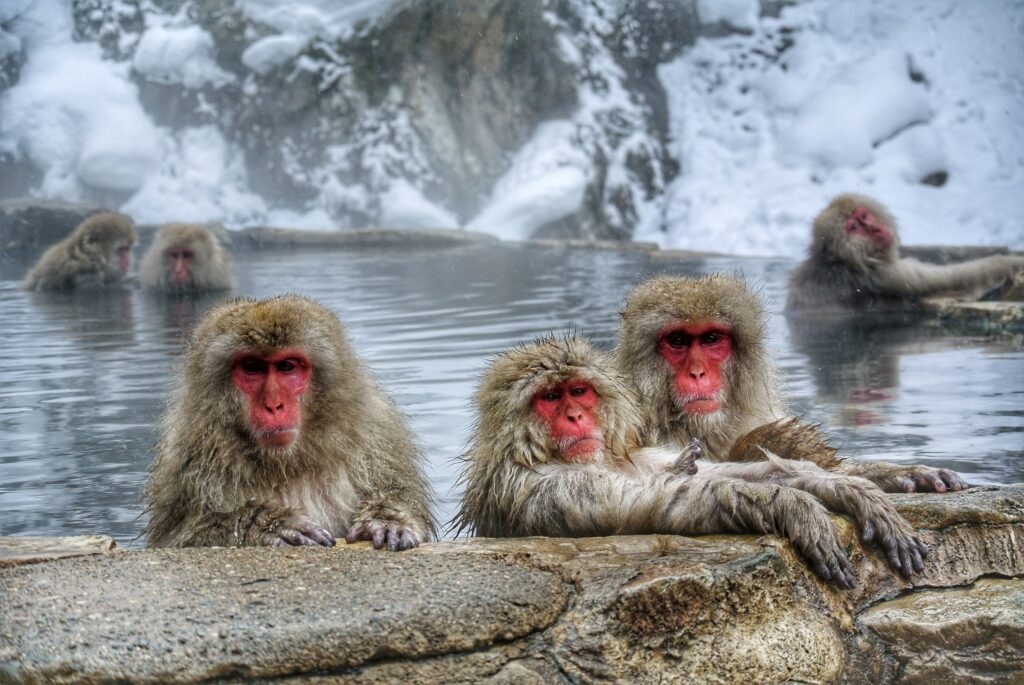The more you snow: The Japanese macaque is not only Japan’s only native monkey species – it’s the only one that lives so far north, often in freezing temperatures. That’s how they also got the name “snow monkeys.” –factanimal.com
You read it first in The Factory in Guide magazine.
Monkeys and apes are always favorites at the zoo! I usually picture them in the warmer climates, swinging from tree to tree in lush forest scenery. But did you know there is a species of monkey that likes the winter weather too?! It is called the Japanese Macaque. And, as you can read above, they got the name “snow monkeys” because they are the only species that lives so far north and in often freezing temperatures. Now, not all of this species of monkey lives in the cold, just some of them. But for those that do, they are very unique, and hold the record for living the farthest north of any other monkey species.
So how do these monkeys survive the cold? Japanese macaques have thick fur that helps them stay warm, especially in snowy regions. Their fur gets thicker when it's cold. They have distinctive pink or red faces and bottoms, and their tails are quite short, more like little stumps. When the cold weather comes, they will eat a lot more to build their energy reserves. They are typically larger and more muscular than their southern cousins.
The monkeys like living in the trees, but are also comfortable on land and water, too. Most species are very good swimmers. Some Japanese macaques, particularly those at Jigokudani Monkey Park, are famous for bathing in hot springs during the winter. This behavior started when people encouraged them to use the springs to help reduce conflicts over food. Bathing in the hot springs helps them stay warm and has even been linked to lower stress levels in the winter.

Their food varies depending on the availability and the season. But they are omnivores, which means they eat food of plants and fruits, as well as of animal matter. For example, on Yakushima Island, they eat a lot of fruit in the summer and herbs in the winter. In colder northern areas, they focus on eating fruits and nuts in the autumn to store fat for the winter when food is harder to find. If their favorite foods aren't available, they might dig up roots or eat fish.
In their groups, there is a clear ranking system. Some monkeys are more dominant than others. The social rank within the group is often passed down through the mother's side of the family. Females usually stay in the group they were born into for their whole lives.
Unlike females, male macaques usually leave their birth group before they are fully grown. They might join other groups or spend time alone before finding a new troop. Males also have a dominance hierarchy, with one male often being the "alpha" or top-ranking male. This alpha position can change over time. The males are typically taller and weigh more than the females.
They live in groups called troops, and are very social. Often, they will help groom each other or sleep close to each other to help stay warm. They will also help each other with the babies, sharing guard duties as well. In snowy areas, macaques have even been observed rolling snowballs, seemingly just for fun!
It was enjoyable to learn about the Japanese macaques! Sounds like they know how to have fun, too - going to the hot springs and playing with snowballs! If you ever wondered what you could do in Heaven, these monkeys can give you lots of ideas!
—Carol Lyons, Assistant
Discovery Mountain
Scripture taken from the New King James Version, Copyright 1982 by Thomas Nelson. Used by permission. All rights reserved.
Learn More About This Fact
For more interesting facts, click on the buttons below!